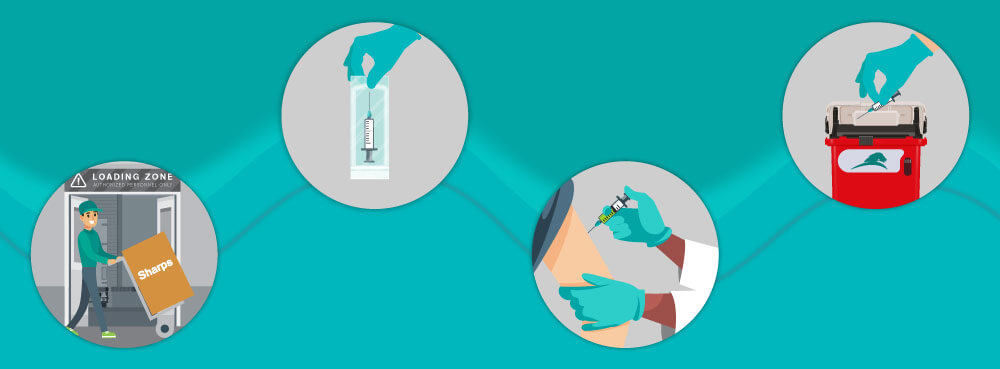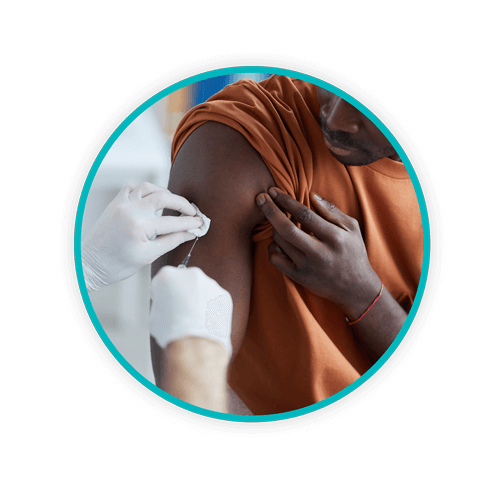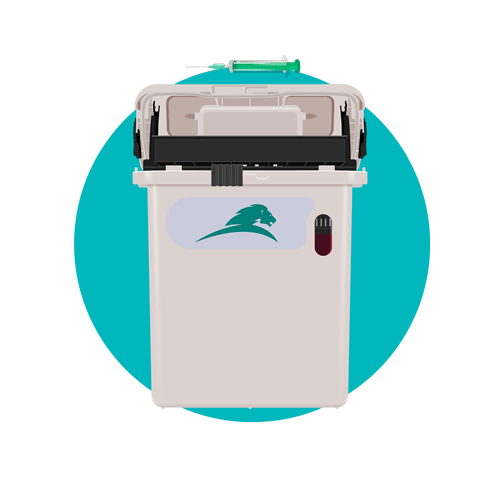A Day in the Life of a Needle

From the moment a package of sterilized needles is received by any healthcare facility or medical provider, certain processes must be relied on in order to ensure safety in the handling of that needle – from the moment it is unpackaged to the moment it is disposed of in a compliant sharps container.
The Occupational Safety and Health Administration (OSHA) defines sharps as any sharp-edged object that has the capability of penetrating or puncturing the skin. That includes anything that ranges from dental wires to needles to scalpels to broken ampules or microscope slides. Needles and needlestick injuries are among primary concerns in healthcare scenarios, so it’s important to carefully and properly handle needles from the moment sterile packaging is opened, throughout its use, and in regard to disposal processes.
TOPICS WE WILL COVER:
2 / Collecting needles and sharps
3 / Compliant disposal of needles
4 / Supporting needlestick safety
During use
During use, needles of any kind, along with hypodermics with needles attached, must be handled with diligence and attention to detail. This is especially important in a patient care scenario. Needles or sharps of any kind must not be left unattended or out of sight of the healthcare professional. It is highly recommended that only one uncapped hypodermic needle is used at a time.
A needle should never be unwrapped or uncovered until you’re ready to use it, and the tip of the needle should always be pointed away from you or others.
Uncapped needles should always be within view of the healthcare professional to ensure safety. Even brief distractions or inattentiveness on the part of a nurse or doctor can result in a needlestick injury. Such scenarios also increase the risk of patients and their visitors being injured in some way from a needlestick or sharps injury.
Always be aware of others around you to ensure safe handling. Don’t cover sharps or needles with other objects in an effort to keep them hidden from the view of patients. Needles should never be passed to someone else in the room to dispose of in a sharps container.
Following the completion of any process, injection, or procedure that involves the use of a needle or syringe, the entire needle system should be discarded into a clearly labeled puncture-proof and leak-proof sharps waste container.
Risks during use – Nurses and healthcare professionals come into contact with needles through their daily work, increasing the risk of an inadvertent poke or needlestick injury. Such injuries caused by unsafe practices can result in contamination with viral infections such as those caused by hepatitis B or hepatitis C. Personnel who are at an increased risk for such injuries include those who work in the emergency room, nurses, surgeons, and lab professionals. With diligence and adherence to protocols, risk of needlestick injuries during use can be drastically reduced.
Collecting needles and sharps
Needles and sharps are to be carefully collected and handled. Do not recap needles. Doing so increases the risk of a needlestick poke. Used needles and syringes should immediately be placed into a compliant sharps container that is marked clearly with the universal biohazard symbol.
Never, ever, put your hand into a sharps container during disposal. Sharps containers should never be more than two-thirds full. Some sharps containers, such as the Sharpsmart, utilize a hands-free disposal process and a safety tray that is built into the container to restrict potential for overfilling. In these instances, containers are designed so that it is not possible to inadvertently stick your hand into them.
Even when using protective devices that include a needle sheath or shield that can be activated immediately after use, it is still essential to handle that needle safely. Training in the use of such devices is essential.
Risk during collection of needles and sharps – Despite guidelines and recommendations to not recap or re-sheath a needle after a treatment or procedure has been completed, the practice still occurs. Most of these incidents occur in cases of an infectious disease or control scenario.
However, failure to properly secure or dispose of needles or other sharps poses an increased risk to housekeeping and/or janitorial personnel. Such risks also increase for those who are responsible for collection and storage of the sharps containers themselves before they are picked up for collection by waste transport companies.
Compliant disposal of needles
Federal, state, and local safety guidelines for safe needle and sharps disposal must be followed not only for compliance, but to prevent injury. In addition to never filling the containers more than two-thirds full and never sticking your fingers into a sharps container, it’s also important to maintain recommendations when it comes to placement of sharps containers in the care setting.
For example, mounting sharps containers at eye level in an examination room provides easy access for disposal of sharps and also preventing tipping of a floor container or inadvertent patient access, especially by children. Needles, whether contaminated or not, are not to be touched by anyone but the healthcare professional making use of the needle or a syringe assembly.
Risks associated with needle disposal processes – Inadequate or missing labeling on sharps containers, regardless of their color (biohazard containers and sharps containers are typically red or reddish-orange in color) increase the risk of mishandling and improper disposal of needles.
Risks associated with improper disposal processes not only include exposure to skin infections or viral infections but fines for non-compliance. A needlestick injury can cost a facility between $800 and $6,000 depending on treatment required.1
Sharps are a regulated medical waste and are also considered a biohazardous waste. Every state can impose fines and/or penalties for non-compliance, as can the Environmental Protection Agency (EPA). Those penalties can rise to tens of thousands of dollars per day, per violation, depending on the severity and the frequency of such violations.
A day in the life of a needle in any medical facility should be understood by all healthcare personnel who come into contact with needles or other sharps in a care setting. Attention to details, knowledge of the rules and guidelines for the use, and proper and compliant collection and disposal processes can prevent sharps and needlestick injuries.
Supporting needle safety
Daniels Health is dedicated to supporting compliant and safe processes within the four walls of all healthcare facilities, regardless of size or purpose. Our innovative and clinical designs for sharps safety are not only environmentally sound and sustainable, but have reduced the potential for sharps and needlestick injuries throughout the country. For more information about our Sharpsmart containers, their safety, and removal processes, contact one of our knowledgeable representatives today.
